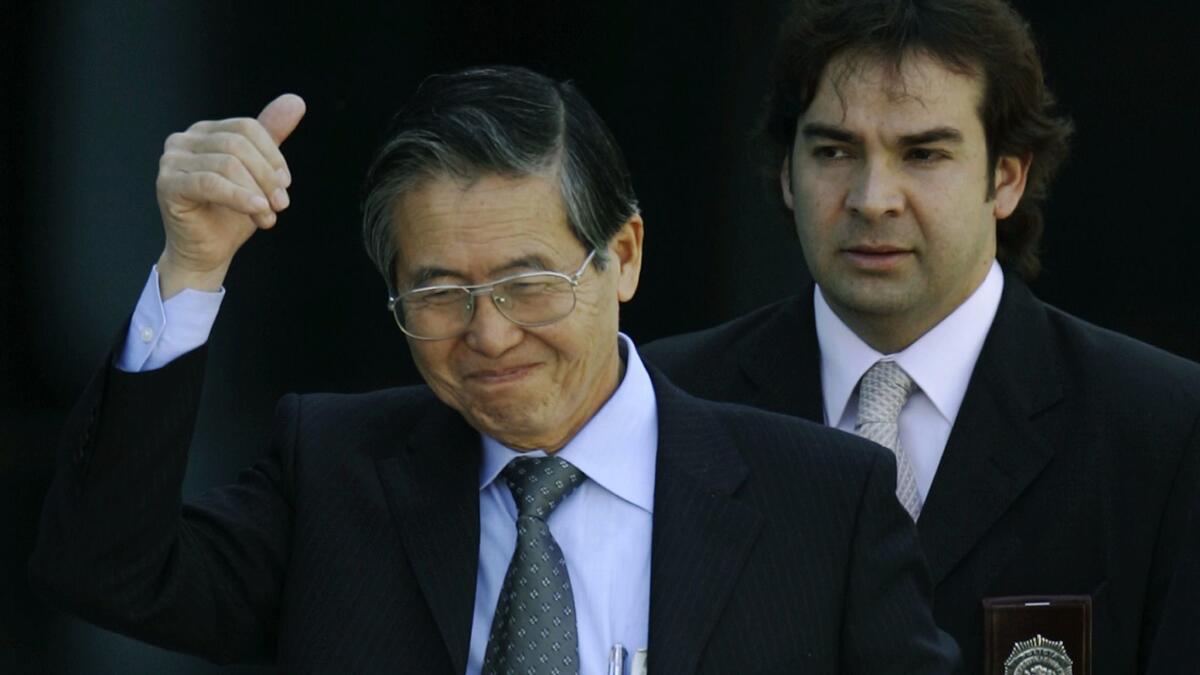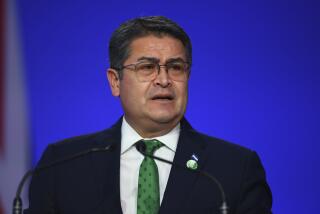Alberto Fujimori, populist Peruvian president swept up in scandal, dies at 86

- Share via
Alberto Fujimori, the once popular Peruvian president credited with rescuing his country from economic chaos and leftist insurgency but who was later disgraced and sentenced to prison on charges of human rights abuses, has died.
His daughter Keiko announced his death Wednesday in a post on the social media platform X.
Fujimori, who had been pardoned in December, died Wednesday in the capital, Lima, his daughter announced. He was 86.
The first man of Japanese heritage to become leader of a Latin American nation, Fujimori was a university administrator who came from nowhere to win the presidency in 1990. Reelected in 1995 and 2000, he resigned in November 2000 after fleeing ignominiously to Japan after videos emerged showing Vladimiro Montesinos — Fujimori’s trusted intelligence czar — bribing other politicians.
An attempted comeback went awry when he was arrested in Chile in 2005 after arriving there from Japan. Chile extradited him to Peru, where he was tried and convicted twice, in 2007 on illegal search charges and again in 2009 on corruption and human rights charges in connection with two mass murders. He was sentenced to 25 years in prison in the latter trial.
When Fujimori took office in 1990, Peru was Latin America’s basket case. Hyperinflation ran at more than 2,000%, the Maoist insurgency called Sendero Luminoso, or Shining Path, controlled half the country, Peru had suspended payments on its foreign debt and the country produced more coca, the base material of cocaine, than any other country.
With tough and unrelenting measures, Fujimori faced down the rebels, greatly reduced coca cultivation and instituted economic reforms that started Peru on the growth path that made it one of Latin America’s fastest-growing economies at the time. His storming of the Japanese Embassy in 1997 to free 72 hostages held by terrorists burnished his tough-guy image.
But, in the end, Fujimori was a victim of his own ego and his conviction that he was “Peru’s indispensable man,” said Shane Hunt, a Boston University economics professor emeritus and Peru expert. An unabashed authoritarian, Fujimori dissolved Congress and suspended the constitution in 1992 to assume powers he said he needed to save the country from ruin.
“He emasculated any public agency that might put a brake on his power,” Hunt said. “He corrupted the promotions process in the armed forces to put his favorites in key commands. He kept judges on interim appointments to remove them if they gave unfavorable rulings. He attempted to amass all power in his own hands.”
Fujimori was broadly accused of sanctioning human rights violations and putting his complete trust in Montesinos, a shadowy character later jailed on embezzlement, bribery and arms smuggling charges. The human rights charges that sent Fujimori to prison were connected to a de facto death squad that prosecutors claimed he had authorized.
His daughter Keiko, one of his four children, served as part-time first lady in her father’s administration and ran unsuccessfully for president in 2011. After her defeat, she led a campaign for the release of her father, saying he should not be permitted to die in prison. His son Kenji is a former congressman who was expelled from office in a bribery scandal.
Fujimori was born July 28, 1938, in Lima, the son of humble Japanese immigrants who ran a tire repair shop. His parents had immigrated to Peru four years before he was born and were part of a wave of Japanese migrants beginning in the 1890s who arrived mainly to work as field laborers in the sugar plantations of northern Peru.
He was an unlikely politician. Holder of a master’s degree in mathematics from the University of Wisconsin, he was an agronomist and president of the National Agrarian University with no electoral experience when he decided to oppose center-right novelist Mario Vargas Llosa in the 1990 election.
Fujimori capitalized on voters’ disgust for politicians and leveraged Japanese Peruvians’ image of efficiency and honesty. Raised Catholic, he drew support from evangelical Christians and lower-middle-class voters for his blunt talk and optimistic approach, playing off Vargas Llosa’s identification with the country’s wealthy white elite and the writer’s unsettling promise of a “shock” austerity program to rescue the country’s dismal economy.
Against all odds, Fujimori won with a 60% majority and soon adopted many of the shock economic measures that he had disparaged Vargas Llosa for advocating. He deregulated industries and eliminated subsidies of gasoline and other goods and services in hopes of turning the tide on inflation.
As daunting as hyperinflation was when he took office, so was the breakdown in security and the growing strength of the Shining Path guerrilla group, which embraced Maoism. He countered the rebels with a massive public works program, establishing the presence of the state in remote towns the government had largely ignored, building post offices, roads, clinics and new schools at a furious rate.
He armed peasants to defend themselves and dealt a blow to the rebels’ morale in 1992 when he captured the Shining Path’s leader, Abimael Guzman.
“He turned his back on Lima, the capital, and spent 10 years in a helicopter visiting villages. He wasted zero time on ideology, and found practical solutions to the economic-security emergency he inherited,” said Richard Webb, a Lima-based analyst who twice was president of Peru’s central bank.
The 1992 “self-coup,” as some observers called Fujimori’s dissolution of Congress, suspension of the constitution and purging of the judiciary, was roundly condemned by the U.S. government and Peru’s neighbors. His military forces also initially occupied radio, TV and newspaper offices and arrested labor leaders and politicians.
Still, his image as a hardworking, no-nonsense leader won over a majority of Peruvians. To paraphrase one Western diplomat, Fujimori sensed Peruvians no longer thought democracy was worth the chaos into which the country had descended. He easily won reelection in 1995 against former U.N. Secretary-General Javier Pérez de Cuéllar.
In 1997, Fujimori directed a commando attack on the Japanese Embassy where guerrillas had held 72 hostages captive for four months. Fourteen rebels, two soldiers and one hostage were killed in the operation, but the bloody rescue might well have marked the high point of his popularity.
After ousting Supreme Court justices to ensure he could run for a third term, Fujimori saw his popularity begin to wane as human rights concerns grew, economic benefits failed to reach those who needed them the most and his authoritative style began to wear thin.
The president’s prestige suffered a serious blow when video evidence emerged showing Montesinos wiretapping the phone of Fujimori’s election opponent Pérez de Cuéllar. Fujimori won a third term in 2000, beating future president and World Bank economist Alejandro Toledo. But after widespread reports of voting irregularities, many regional leaders shunned his swearing-in festivities.
Fujimori sent in his resignation by fax in November 2000 during a trip to Japan, shortly after Montesinos fled the country. The president’s subsequent hasty exile baffled many of his supporters and led to conjecture that perhaps there were incriminating videos of him as well.
Japan declined Peru’s extradition request for Fujimori, who held Japanese citizenship. Despite the fact that he faced 500 charges back home, Fujimori attempted a political comeback in 2005 by returning from exile. Chilean authorities arrested him upon arrival there and extradited him to Peru in 2007 to face human rights, murder and kidnapping charges.
His critics said that Fujimori’s return was a gamble that Chile wouldn’t extradite him and that he could use Peru’s neighbor as a jumping-off point for another presidential bid. But his daughter told The Times in a 2008 interview that her father expected to be arrested and that he hoped that during the extradition process, many of the outstanding charges against him would be dropped, which turned out to be the case.
“When I was studying for my master’s in New York, he called to tell me he was on an airplane and that there was a good chance he’d be arrested,” his daughter said. “But I never heard him sound so happy.”
After a marathon 15-month trial, Fujimori was convicted in April 2009 on charges he ordered kidnappings and two massacres that claimed the lives of 25 people in 1991 and 1992. He was sentenced to 25 years in prison.
He received a presidential pardon in 2017 because of his declining health, but years of legal wrangling followed. In December, Peru’s Constitutional Court ruled in favor of the humanitarian pardon and Fujimori was released.
Kraul is a former Times correspondent. Former Times staff writer Steve Marble and the Associated Press contributed to this report.
More to Read
Start your day right
Sign up for Essential California for the L.A. Times biggest news, features and recommendations in your inbox six days a week.
You may occasionally receive promotional content from the Los Angeles Times.







